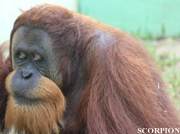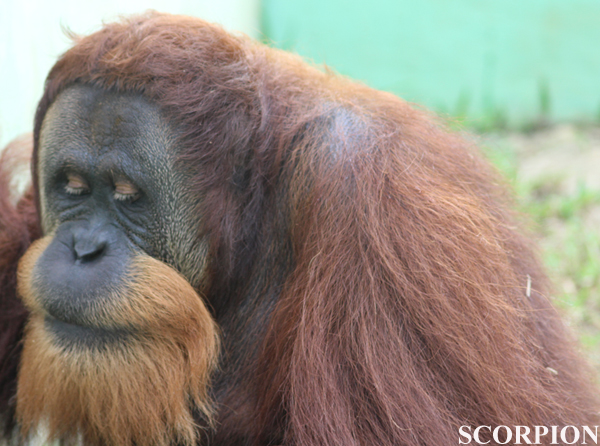
Discover something new about these endangered and enigmatic apes. (August 20, 2015)
Orangutans are semi-solitary in the wild (unlike other higher primates). Once they reach maturity, they spend most of their time alone, or, in the case of females, with their immature offspring. Adult males old enough to have cheekpads are the most solitary, spending over 90 per cent of their time alone.
2. Orangutans live on only two islands, Borneo and northern Sumatra. They are a relic species. At the end of the Pleistocene period some 12,000 years ago, their range was much wider, encompassing southern China, Indochina, Java and southern Sumatra. The species is now extinct in all these regions.
3. Orangutans are the largest tree-dwelling animals on Earth. Though adult male gorillas climb up to the canopy to feed, they do not spend much time there and are basically terrestrial. Adult male orangutans, reaching a weight of 140kg or more, spend over 90 per cent of their time in the treetops, eating ripe fruit, young leaves and the occassional termite or vine. Adult females spend even more time in the canopy.
4. Adult male orangutans develop cheekpads, which frame their faces and make their heads look larger. In captivity, males as young as 13 develop cheekpads, but in the wild, some males may not grow them until the age of 30. Once a male has his cheekpads, he won't tolerate any other adult males in his vicinity and competes with them for access to receptive females. Cheekpads may also serve an acoustic function in helping project the 'long call' a male uses to broadcast his presence through the dense forest.
5. Orangutans are among the most sexually dimorphic of primates. An adult male may be three times heavier than an adult female. He also sports large cheekpads, a throat pouch that acts as a resonating chamber for his loud call, and a muscular body from a testosterone surge at an earlier stage of life. Males use their large size to compete with each other for access to receptive females.
6. Orangutans have the most intense relationship between mother and young of any non-human mammal. Mothers carry their offspring for the first five years, and may suckle them for six or seven years. For the first eight years of a young orangutans life, its mother is its constant companion. Until another infant is born, mothers sleep in a nest with their offspring every night.
7. Orangutans have the longest birth interval of any mammal. In Borneo, they give birth on average once every eight years. In Sumatra, some females may only give birth once every 10 years. Females often do not breed until the age of 17. If adult females are killed, the population takes a long time to recover.
8. Orangutans are the only great apes of Asia. It appears that they are of African origin but dispersed about 15 million years ago. During the Miocene period, there were many ape species throughout Africa, Asia and Europe. Chimpanzees, bonobos and gorillas survived in Africa, but only the orangutans survived in Asia.
9. Orangutans are gentle and sit for hours gazing. Though males can be aggressive, I have followed orangutans for 36 years and have never been attacked or even chased.
10. Orangutans are very smart. They perform as well as chimpanzees and gorillas in tests of cognitive ability. In captivity, they are excellent tool-users and versatile tool-makers. One captive orangutan was taught how to chip a stone hand-axe. In the wild, one population makes and uses tools for opening and extracting fruit in a sophisticated manner reminiscent of chimpanzees – except that these orangutans hold the tools in their mouths.
5 THINGS EVEN THE EXPERTS DON'T KNOW ABOUT ORANGUTANS
1. Why are orangutans orange?
Orangutans 'blaze' in the sunlight but virtually disappear when they move into shadow. In the shade of the canopy, their tan skin absorbs the light so you don't see the sparse hair but the dark skin underneath. Then they become functionally black. Could this now-you-see-me-now-you-don't combination be adaptive? Or, given that they generally don't congregate in groups, does their bright orange colour announce their presence to others of their species? We simply don't know.
2. How long do orangutans live in the wild?
We can only make educated guesses. In captive environments, orangutans have lived for over 60 years. Wild females at my study site who were adolescents back in 1971 are still alive today and bearing offspring. A formerly captive female in her 40s recently had an infant. My guess is that wild orangutans may live into their 70s, but I believe this is rare.
3. How far do orangutan males travel in their lifetime?
They travel greater distances than females. I suspect they may wander hundreds of kilometres away from their mothers' home ranges. In the space of one year, one adolescent male travelled a distance of more than 30km as the crow flies.
4. Were orangutans ever more gregarious than they are now?
This is possible. Ex-captive individuals associated with rehabilitation programmes tend to be more gregarious than wild orangutans. If wild populations lived in fertile lowland areas with abundant concentrations of food, they might have been more gregarious. Since humans have destroyed such forests to use the land for agriculture, sociable orangutans, if they ever existed, are long gone.
5. Will they escape extinction?
The massive destruction of the orangutans habitat – the tropical rainforests of Borneo and Sumatra – is catastrophic. We are working to save the species and its habitat, but the forces arrayed against the orangutan are so formiddable that perhaps, if we (and they) are lucky, just one or two populations may survive.

Source: DiscoverWildlife